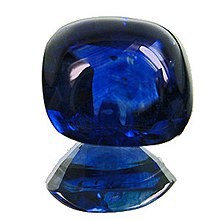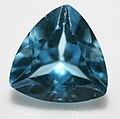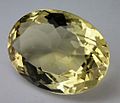Cut (gemstone)
In gemology, cut is the type and shape of gemstones created by grinding in order to increase their shine and emphasize the optical effects inherent in the stone .
The choice of cut as well as the quality of the execution are decisive for the later value of the gemstone in addition to color and purity. Due to the experience required for this, among other things with the different properties of the materials used as gemstones, high-quality cuts for commercial use are usually carried out by specially trained gemstone cutters.
Cut type
When grinding gemstones, a distinction is made between three different types of cut, which take into account the particular characteristics of the stone.
Smooth finish
With smooth sanding, a smooth surface is created without any edges except for a possible girdle. It is preferably used for opaque to translucent gemstones. These often show a lively play of colors such as grains and spots. The smooth cut is also the only shape that fully unfolds special optical effects such as adularescence , asterism and chatoyance as well as the silky sheen typical of these stones.
The most famous smooth cut is the cabochon , but also able stones , ball - and Tumbled (Baroque stones) are among the smooth sections.
Cabochon cut on the moonstone
Various spherical cut crystals
Jasper in egg shape
Chrysocolla - malachite aggregate as tumbled stone
Facet cut
The facet cut has been known around the 15th century and consists of a large number of small, smoothly polished surfaces, the facets . It is mainly used with transparent stones, as they are able to reflect incoming light , refract it and often split it up in multiple colors ( dispersion ). This phenomenon, the fire of a stone, is intensified in particular by the modern full brilliant cut , which was developed in 1910. The optimal refraction of light is achieved through precisely defined angular relationships between the 57 facets (32 facets plus table in the upper part, 24 facets in the lower part) arranged according to a specific scheme. In rare cases, the point in the lower part is blunted by a culet in order to reduce the risk of damage such as cracks. However, since the culette always leads to a reduction in value of the stone (lower weight and visible, dark point when looking at the table from above), this is avoided by grinders as far as possible.
The brilliant cut was preceded by continuous development. First, only the natural octahedron surfaces of the diamonds were polished, before the creation of additional facets was gradually started.
Most of the facet cuts can be classified into two basic types: the already mentioned brilliant cut for more round shapes and the step cut for more angular shapes. There are also special shapes such as the rose cut , the oval and the pendeloque for round shapes, as well as the emerald cut and the scissor cut for angular ones.
Mixed cut

Finally, with the mixed cut, smooth and facet cut are combined with one another. Depending on the desired effect or fashionable taste, the upper side is designed as a cabochon and the underside as a facet cut ("Buff Top") or two different facet cuts are selected for the top and bottom. In some cases two types of cuts are combined on one side.
For example, the “Ceylon cut” (also Ceylon cut ) is one of the mixed cuts in which the upper part is a scissor cut and the lower part is a step cut. In contrast to this, with the "Indian cut" the upper part is made in a step cut and the lower part in a scissor cut.
Cut shape
When defining cut shapes, the cutter refers to the geometric shape of the later gemstone. These are derived from the classic, geometric shapes such as B. the circle and the square. The cuts are differentiated according to the following basic shapes:
Polygons
-
Triangle ( Triangle , Trillant ): Triangular basic shape in the brilliant cut version with table, six square and 18 triangular facets. It is also possible to have a stepped cut.
- "Coat of arms" or "shield": Fantasy cuts in the form of a coat of arms or shield in a stair cut.
-
Squares
- Square ( Carré ), brilliant and step cut possible
- "Cardinal cut": star cut ( double star ) with a square cross-section
- " Cushion cut " (also known as cushion cut or candelight cut ): The shape is square with rounded corners, resembling the shape of a pillow.
- Rectangle ( baguette )
- "Oblong": elongated rectangular shape with rounded corners.
- "Ceylon-cut" and "Indian cut" in a mixed cut with rounded corners
- Rhombus or lozenge
- "French-Cut" (also Frenchcut ): Special shape with a square cross-section and square table as well as 8 triangular facets on the top. The lower part is optionally available in a step or brilliant cut.
- Trapezoid: trapezoidal step cut
- Square ( Carré ), brilliant and step cut possible
-
Pentagon ( Pentagon )
- "Epaulette cut": A pentagon variant belonging to the antique cut, the shape of which is based on the French shoulder piece ( epaulette )
- Hexagon ( hexagon ) and as a fantasy touches to the six-pointed "Star Bright".
-
Octagon (also octagonal or Octagon )
- "Asscher cut": The basic shape is a square, but with cut corners, similar to the emerald cut
- "Emerald cut" (also octagonal cut or emerald cut ): Octagonal step cut
- "Star brilliant": Fantasy cut in the shape of an eight-pointed star
- Freeform ( bastard cut )
Triangular cut blue topaz
Square cut elbaite
Green tourmaline in emerald cut
Scissors-cut ametrine
Zirconia as an eight-pointed "star diamond"
Circle , ellipse - and egg shapes
- simple round cut with table and several concentric stairs in 16 segments
-
Brilliant cut (also full brilliant or highlight brilliant ): Cut with a circular girdle, at least 32 facets plus table in the upper part, at least 24 facets plus, if necessary, culet in the lower part
- "Octagonal" (also octagonal cut or simplified brilliant cut ): Special diamond cut with table, 8 upper and 8 lower facets
- Double brilliant
- "English square cut" (also English double cut or English square cut brilliant ): Early form of the brilliant cut with an octagonal table and 16 facets on the upper part and 12 facets on the lower part
- "Star cut": a brilliant cut in which the facets run from the girdle to the center and form a star-shaped pattern
- "English star cut": brilliant cut with 16 facets on the upper part and 12 facets on the lower part
- "Fan cut": brilliant cut in which the facets are laid out in a fan shape from the outside to the inside or from the inside to the outside
- " Radial cut " (also
-
Rose cut (also simple rose , Dutch rose or Amsterdam rose ): Cut with a flat lower part and 24 triangular facets on the curved top
- "Antwerp Rose" ( Brabanter Rose ): Old European cut from the 16th century with 12 trapezoidal and triangular facets
- Double rose: 32 triangular facets on the curved surface.
- as special shapes or fantasy cuts are derived from it, among other things, the "Recoupé-Rose", the "Jubilee-Cut" with 80 rosette-shaped facets that form a point towards the top, and the "Needle Diamond"
- "Oval": Elliptical cut as a brilliant cut with a central table, 8 square and 24 triangular facets on the top
- " Navette " or "Marquise": ellipse, the transitions of which taper to a point in the large diameter
- " Pendeloque ": Egg-shaped cut with a central plate, 8 square and 24 triangular facets on the top
- "Tonne": Oval step cut, the sides of which have been cut off
Full brilliant cut zirconia with a typical diamond fire
Prehnite in "petal cut"
Diopside Navette
Dresden Green Diamond in Pendeloque cut (copy)
Three-dimensional shapes
- "Ball": spherical brilliant cut
- "Olive": Olive- shaped brilliant cut
- "Briolette": teardrop- shaped facet cut with triangular, diamond or trapezoidal facets
- "Pampel": teardrop-shaped brilliant cut with conically arranged, elongated facets and truncated cone tip.
Briolette cut rock crystal
Large star of Africa in broad teardrop or pear shape
Garnet in spherical ground
Further cuts
- "Antique cut": Square or rectangular cut in brilliant or step cut with rounded corners
- "Balloon cut": facet cut with outwardly curved facets
- "Barion cut": Rectangular or octagonal basic shape with stepped cut on the top and conical faceting on the underside
- "Context Cut": Modern, octahedron-shaped cut with a flatter top , developed by Ulrich Freileben and Bernd Munsteiner in the 1990s
- "Flower Cuts": Modern diamond cuts in the forms " zinnia " ( Zinnia ), " Marigold " ( Marigold ), "Fire Rose" ( Fire Rose ), " Sunflower " ( Sunflower ) and " Dahlia " ( Dahlia ).
- "Gabrielle-Cuts": Special cut shapes patented by Gabi Tolkowsky
- "Heart" (also heart cut ): Heart-shaped brilliant cut
- "Lenticular cut": stepped cut in which the facets of the upper and lower parts run in one direction.
- "Princess cut" ( princess cut ): mixed pulp with Cardinal cut on the upper part and the flap-grinding the base.
- "Radiant": Mixed diamond cut with step cut on the upper part, brilliant cut on the lower part and a total of 70 facets.
- "Table cut", also seal, flat, plate or ring stone cut: Simple facet cut, in which the table is the predominant facet on the top and usually also on the underside.
literature
- Walter Schumann: Precious stones and gemstones. All species and varieties in the world. 1600 unique pieces . 13th, revised and expanded edition. BLV Verlag, Munich et al. 2002, ISBN 3-405-16332-3 , p. 80-81 . (with illustrations of the different cuts in the cover)
- Ulrich Henn: Gemstone Dictionary . Ed .: German Gemmological Society. Self-published, Idar-Oberstein 2001, ISBN 3-932515-24-2 .
Web links
- Jewelry Encyclopaedia of Prof. Leopold Rössler: Schliffart and cut form at beyars.com
- PONS picture dictionary - cut shapes for gemstones (drawings of oval cut, briolette, pendeloque, Frenchcut, baguette and navette)
- Gemstone cuts at carat-online (antique, baguette, brilliant, carreé, heart, hexagon, navette, octagon, oval, princess, round, triangle, drops)
- goettgen.de (MAR Edelstein GmbH) - Illustration of the most common currently gemstone cuts ( Memento of 7 April 2014 Internet Archive ) (PDF 551.3 kB)
Individual evidence
- ↑ Jewelry dictionary by Prof. Leopold Rössler - mixed grinding
- ↑ The essential 7C - cushion grind ( cushion ). In: 77diamonds.com. 77 Diamonds, accessed May 13, 2019 .
- ^ Jewelry dictionary by Prof. Leopold Rössler - Epaulette cut
- ^ Jewelry dictionary by Prof. Leopold Rössler - octagonal cut
- ↑ The essential 7C - Asscher cut. In: 77diamonds.com. 77 Diamonds, accessed May 13, 2019 .
- ↑ Free life diamonds - Spirit Sun
- ↑ a b Anne Preissner: diamond cutters from Münster . In: Manager Magazin . March 14, 2008.
- ^ The large art dictionary by PW Hartmann - Antwerpener Rose
- ↑ Free life diamonds - Context Cut
- ^ Jewelry dictionary by Prof. Leopold Rössler - Tafelschliff






























